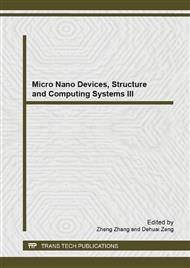[1]
Z. Libo, J. E. Fletcher, B.W. Williams and H. Xiangning, A Novel Direct Torque Control Scheme for a Sensorless Five-Phase Induction Motor Drive, IEEE Transactions on Industrial Electronics, vol. 58, issue 2, p.503 – 513, (2011).
DOI: 10.1109/tie.2010.2047830
Google Scholar
[2]
A.M. Bazzi, A. Dominguez-Garcia and P.T. Krein, Markov Reliability Modeling for Induction Motor Drives Under Field-Oriented Control, IEEE Transactions on Power Electronics, vol. 27, Issue 2, p.534 – 546, (2012).
DOI: 10.1109/tpel.2011.2168543
Google Scholar
[3]
C.M. Liaw and F.J. Lin, A Discrete Adaptive Induction Position Servo Drive, IEEE Trans. on Energy Conversion, Vol. 8, No. 3, pp.350-356, (1993).
DOI: 10.1109/60.257044
Google Scholar
[4]
J.Y. Sun, W. Shi and Z.C. Wang, The application of the phase plane in the tuning method for fuzzy PID, in Proc. 2012 2nd International Conference on Consumer Electronics, Communications and Networks (CECNet), p.1381 – 1385, (2012).
DOI: 10.1109/cecnet.2012.6202039
Google Scholar
[5]
W.C. Wu and M.S. Tasi, Application of Enhanced Integer Coded Particle Swarm Optimization for Distribution System Feeder Reconfiguration, IEEE Trans. on Power Systems, Vol. 26, Issue. 3, pp.1591-1599, (2011).
DOI: 10.1109/tpwrs.2010.2094212
Google Scholar
[6]
Y. Wang andY. Yang, Particle swarm with equilibrium strategy of selection for multi-objective optimization, European Journal of Operational Research, Vol. 200, Issue1, pp.187-197, (2010).
DOI: 10.1016/j.ejor.2008.12.026
Google Scholar
[7]
P.C. Krause, Analysis of Electric Machinery, NY, McGraw-Hill, (1987).
Google Scholar
[8]
C.M. Liaw and F.J. Lin, Position Control with Fuzzy adaptation for Induction Servomotor Drive, IEE Proc. Electr. Power Appl., Vol. 142, No. 6, pp.397-404, (1995).
DOI: 10.1049/ip-epa:19952209
Google Scholar
[9]
B.C. Kuo, Automatic Control System, NY, John Wiley & Sons, (1995).
Google Scholar
[10]
C.L. Chiang, Improved genetic algorithm for power economic dispatch of units with valve-point effects and multiple fuels, IEEE Transactions on Power Systems, Vol. 20, No. 4, pp.1690-1699, Nov. (2005).
DOI: 10.1109/tpwrs.2005.857924
Google Scholar
[11]
C.L. Chiang, Immune-based Algorithm for Power Economic Emission Dispatch, International journal Applied Mechanics and Materials, Vol. 470, pp.785-789, (2013).
DOI: 10.4028/www.scientific.net/amm.470.785
Google Scholar


